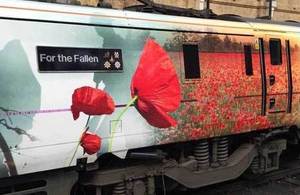Train takes centre stage at a ceremony of remembrance
Secretary of State for Transport joined military personnel to welcome the ‘For the Fallen’ at Kings Cross Station.

For the Fallen
A ceremony of remembrance was held at King’s Cross Station to mark the centenary of the First World War today (7 November 2014). Secretary of State for Transport Patrick McLoughlin was joined by 100 serving and retired military personnel who gathered to greet East Coast locomotive 91111 For the Fallen.
The nameplate of the newly-renamed train bears the crests of regiments local to the East Coast route, and the train’s livery depicts soldiers, artefacts and tributes commemorating the contribution they made to the war efforts.
The For the Fallen locomotive was met by servicemen and women lining the platform at King’s Cross. The Secretary of State for Transport gave a short speech in a ceremony that included a multi-faith act of remembrance followed by the playing of the Last Post.
Transport Secretary Patrick McLoughlin said:
World War 1 is also known as the railway war because of the significant role trains played in the conflict. Trains transported supplies and soldiers to and from the frontline and kept the country going. The railways are just as important to the nation now as they were was 100 years ago.
Today’s ceremony and the For the Fallen locomotive are a moving reminder of the sacrifices made by our forefathers in the Great War and in wars since. It is important that we remember their sacrifice, and that we never forget the lessons of the past. I am honoured to have been able to commemorate their work today.

Mark Carne (Chief Executive Network Rail), Michael Holden (Directly Operated Railways Chief Executive), Karen Boswell (Managing Director of East Coast Trains), Patrick McLoughlin MP (Secretary of State for Transport) and Michael Portillo.
When war was declared on 4 August 1914 the railway helped troops to mobilise, and by the end of that month dedicated military supply trains were arriving at Southampton every 12 minutes throughout the day. Thousands of railway workers enlisted to fight, and women stepped into many of their roles on the Home Front, eventually performing most of the railway tasks.
It is estimated that the railway lost 20, 000 men during World War 1, and many main line stations in Britain have a memorial to their sacrifice, listing the names of those who worked on the railway but never returned to their jobs when peace was restored in 1918.
Chairman of East Coast and Chief Executive Officer of Directly Operated Railways Michael Holden said:
The rail industry is rightly marking the centenary of World War 1. The ‘For the Fallen’ locomotive is East Coast’s individual tribute to those who went to war: it also commemorates those who gave their lives, including the 20,000 rail workers who signed up for the war, never to return.
The For the Fallen locomotive takes stories, images, facts and history behind the 5 regiments, and the Great War, to millions of our passengers across the country. We worked on the detail of the livery with 5 regiments on the East Coast route, including the Honourable Artillery Company (HAC).
The locomotive is a powerful and poignant symbol of commemoration by our railway industry for all those who did not return from the Great War. Lest we forget.
Loco 91 111 For the Fallen joins sister East Coast electric locomotive 91 110 ‘Battle of Britain Memorial Flight’, which features the insignia of the Royal Air Force Battle of Britain Memorial Flight (RAF BBMF) and its 3 famous World War 2 aircraft – the Spitfire, Hurricane and Lancaster.
Rail and major projects media enquiries
Media enquiries 0300 7777878
Switchboard 0300 330 3000
Related documents
- East Coast unveils new blog and ‘For the Fallen’, 31 October 2014